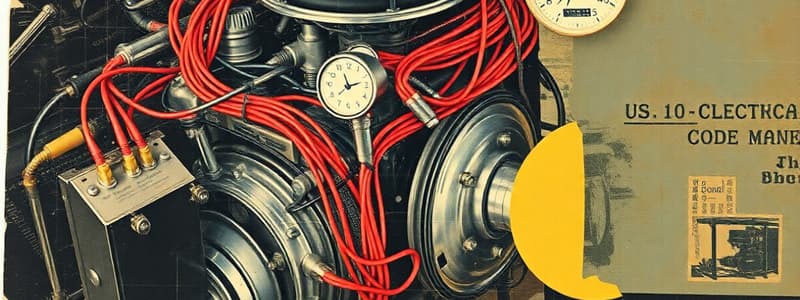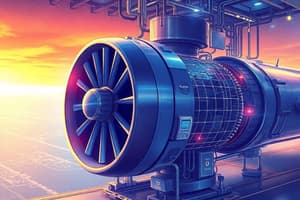Podcast
Questions and Answers
What should you do whenever you change an engine's oil?
What should you do whenever you change an engine's oil?
Perform a visual inspection of the different systems under the hood.
Which of the following should be checked when inspecting the cooling system?
Which of the following should be checked when inspecting the cooling system?
- Hoses
- Radiator
- Coolant level
- All of the above (correct)
The coolant level should be checked at the radiator.
The coolant level should be checked at the radiator.
False (B)
What should be done if the coolant looks rusty or cloudy?
What should be done if the coolant looks rusty or cloudy?
What does a coolant hydrometer measure?
What does a coolant hydrometer measure?
Which types of belts drive various engine components?
Which types of belts drive various engine components?
Flashcards
Minor engine electrical system service
Minor engine electrical system service
Routine maintenance tasks on the electrical components of a vehicle's engine.
Replacing system assemblies
Replacing system assemblies
Replacing parts of the engine electrical system.
Minor Adjustments
Minor Adjustments
Making small changes to the engine's electrical systems.
Coolant condition check
Coolant condition check
Signup and view all the flashcards
Coolant hydrometer
Coolant hydrometer
Signup and view all the flashcards
Drive belts
Drive belts
Signup and view all the flashcards
Cooling system hoses
Cooling system hoses
Signup and view all the flashcards
Radiator
Radiator
Signup and view all the flashcards
Coolant level check
Coolant level check
Signup and view all the flashcards
Post-service/Pre-delivery check
Post-service/Pre-delivery check
Signup and view all the flashcards
Study Notes
Automotive Mechanics NTQF Level II Learning Guide #3
- Unit of Competence: Perform minor Engine Electrical Systems Service
- Module Title: Performing minor Engine Electrical Systems Service
- LG Code: EIS AUM2 M02 LO3-01
- TTLM Code: EIS AUM2 M04 0322
- Unit 3: Replace/Reassemble System Assemblies
Learning Guide Instructions
- Content Coverage: Carryout minor adjustments, Assembling system components, Conducting post-service/pre-delivery check
- Learning Outcomes: Carry out minor adjustments, Assemble system components, Conduct post-service/pre-delivery check
- Learning Activities: Read specific objectives, Read information sheets (pages 2), Accomplish self-check 3 (page 71), Teacher evaluation (satisfactory/unsatisfactory)
LG3: Replace/Reassemble System Assemblies
- Carrying Out Minor Adjustments: Visual inspection of cooling system hoses for leaks/damage (replace if needed), check radiator for leaks/dirt build-up (clean if necessary), check coolant level ("low" to "full" lines), use correct coolant type (green/orange, not rusty/cloudy), flush coolant system if contaminated.
- Coolant Condition: Use a coolant hydrometer to check antifreeze concentration (pickup/reservoir/squeeze bulb).
- Drive Belts: V-belts/V-ribbed belts used to drive various engine components (water pumps, power steering pumps, etc.).
- Inspection: Check condition of V-belts (worn/glazed edges, tears, splits, oil soaking, rust on pulleys, wear, damage); alignment (within 1/16 inch per foot). Maintain service life, and address pulley wear, misalignment.
Assembling System Components
- Specific instructions for connecting various parts of the engine (injector nozzle, cooling system, exhaust pipe, fuel pipes, high-pressure fuel pipes, nozzles, fuel filter).
- Instructions for connecting fuel pipes (fuel/electrical lead at thermostat), air/induction/exhaust manifolds, cooling system.
Conducting Post-Service/Pre-Delivery Check
- Documenting Results: Documentation is vital to record an organization's development, acquisition processes, and operation maintenance of technology systems. Documentation supports efficient usage of technology, accurate maintenance, and identifies/corrects program defects.
- Final Inspection: Ensure vehicle is returned in proper working condition with all safety features (brake system) checked, and all required work completed.
- Service Provision: Use job cards/checklists for rarely used procedures (instructions/steps), and record observations/documents.
- Record/Documentation: Running record of observations (every two minutes), capture problems, record completed work, maintain proper report formats/procedures. Time sampling used to record engine part repairs.
Studying That Suits You
Use AI to generate personalized quizzes and flashcards to suit your learning preferences.




